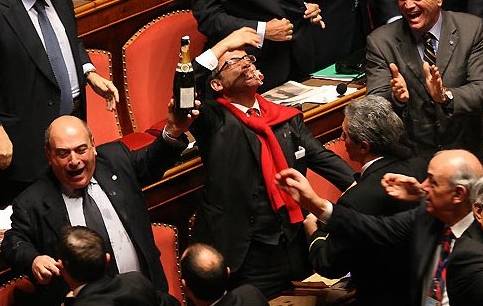Italy. Slouching into the New Decade
Down at Ermete’s bar in Trevignano Romano on the day after New Year’s two of the grizzled men who still make their living on the land and fishing on the lake were talking. Reminding me of Cipputi and his fellow workman Bobo, popular figures drawn by political cartoonist Altan, the two were discussing Paolo Bonaiuti’s update on Silvio Berlusconi’s return to health. Bonaiuti is Silvio Berlusconi’s sometime speech writer and alltime sidekick. Indeed, he is so much a friend of the Premier that when Silvio speaks, Bonaiuti has been seen to mouth the words, laced with appropriate underscoring gestures with hands and sweeping arms.
First fisherman: “On the radio this morning Bonaiuti also said that Berlusconi’s spirits are good.”
Buddy fisherman (long sardonic pause): “Not mine.”
And who can blame him? Slouching into the new decade after the one best forgotten, the observer can hardly miss seeing that there are two conflicting sets of problems beleaguering Italy. The first are the distracting and futile political catfights. Their tone is nasty, and they involve such political leaders as the endlessly aggressive ex-magistrate Antonio Di Pietro on the left, the grumpy Northern Leaguer Roberto Calderoli on the populist right, and the no less aggressive rightist economist Renato Brunetta, today Minister for Public Administration.
Brunetta wins the prize for his lugubrious insult of last September, “Vada a morire ammazzata la sinistra che prepara colpo di Stato.” (The left that’s preparing a coup d’etat should be shot.) Considering that the Italian left (what left? where? which lefts?) could not prepare so much as a children’s party for La Befana, this gratuitous claim was needlessly antagonistic and certainly not part of any solution.
The same is true of the recent statement by Dr. Calderoli of Bergamo, whose contribution to Church-State relations was this: “Nobody listens to a priest who talk politics.” The back story: Milan Archbishop Dionigi Tettamanzi was urging kinder treatment of immigrants, who, he said, should not be automatically criminalized, and the cities of Italy not “militarized,” as the far right in the North has demanded.
In the second category are the real problems hurtling toward Italy, no less than other countries, but with a few specifically Italian aggravating factors. An example: the pending closure of the Fiat auto manufacturing plant in Sicily because each car produced there comes off the assembly line costing E 1,000 more than in the North. In an end-of-decade survey, one Italian economist was asked which European countries were in the worst trouble. He listed, in this order, Ireland, Portugal, Spain, Southern Italy, and all of East Europe except Poland.
At the same time, despite the efforts of its famously capable businessmen and industrialists, the North of Italy is facing new risks that can potentially overwhelm social services there. ISEE is the organization which sets the official poverty-line economic benchmark. ISEE also distributes the permits that bring hand-out checks for families with more than three young children and distributes the permits that give the needy access to, among other things, free school books, university scholarships, day-care, maternity aid, invalid transportation, visiting nurses and, in Sicily, exemption from payment of the already cut-rate health service fees. Extracts from its annual report, published January 3 in the financial daily Il Sole-24 Ore, show that one million more than last year made claims to free social welfare services. In the South one out of two citizens—50%--made these requests.
In the North the figure is half that, but with a new and rapidly increasing problem. The number of the foreign-born (and especially from Asia, Africa and East Europe), who are officially designated by ISEE as below the poverty line, and who are skillful enough to have learned the bureaucratic ropes, has literally tripled in the past three years, so that they make up 18%, or nearly one out of five of those in need of help from the local and state social services.
And this is the interconnected problem: Italy needs its migrant workers, just as other countries do. But management of their needs and of their successful insertion into Italian society is complex and requires political and bureaucratic skills that are not yet available, given the rhetorical distractions.
In the ancient fishing village cum modern dormitory suburb of Trevignano in Lazio, a beloved holiday tradition is to make Christmas-time Nativity scenes. The largest has a real donkey, real cow, goats, sheep, piglets and life-sized characters, down to and including an Arab vendor and a seated black beggar with only one leg, itself a comment. The most moving, by way of contrast, is a double Presepe scene carved into a giant rock. One miniature grotto shows the traditional Christ Child and the adoration of the Magi. The other shows the troubled Isle of Lampedusa, the goal of hundreds of desperate migrants every week. As a thoughtful hand has written, when a rickety boat loaded with would-be migrants sank just off the coast of Italy, the crying of a drowning babe was heard in the the waves—a reminder that many lack so much as a manger. And a reminder too that kind hearts, like the author of the “presepe” and Archbishop Tettamanzi, coexist with the ironically misnamed new politics of “love.”





































i-Italy
Facebook
Google+
This work may not be reproduced, in whole or in part, without prior written permission.
Questo lavoro non può essere riprodotto, in tutto o in parte, senza permesso scritto.